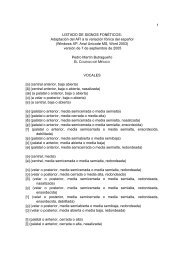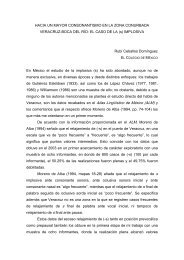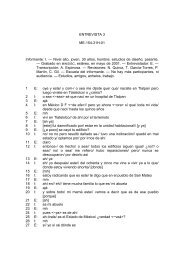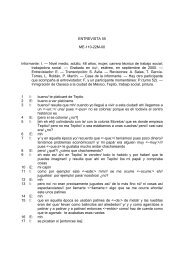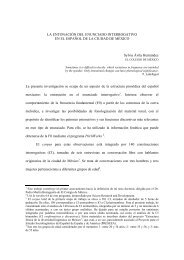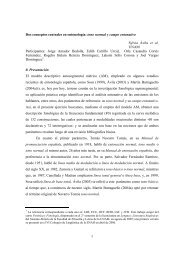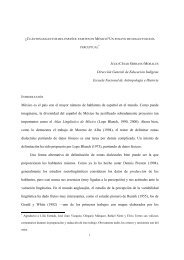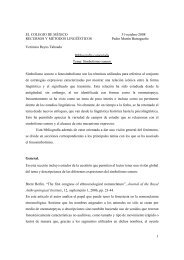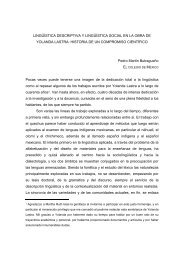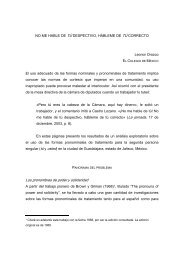PROYECCIÓN SINTÁCTICO-DISCURSIVA DE LA ENTONACIÓN ...
PROYECCIÓN SINTÁCTICO-DISCURSIVA DE LA ENTONACIÓN ...
PROYECCIÓN SINTÁCTICO-DISCURSIVA DE LA ENTONACIÓN ...
Create successful ePaper yourself
Turn your PDF publications into a flip-book with our unique Google optimized e-Paper software.
corresponde a una f= 0.90 (76/84) 8 de A+C en el análisis acústico, con una p de regresión<br />
logística, binomial y escalonada, de 0.925 9 .<br />
<strong>LA</strong> CONTRIBUCIÓN <strong>DE</strong> KVAVIK<br />
Aunque es pertinente considerar varias de las investigaciones de Karen Kvavik, quisiera<br />
referirme ahora en especial a las observaciones contenidas en un trabajo de 1979, “An<br />
interpretation of cadences in Mexican Spanish”, que vincula de manera muy llamativa las<br />
configuraciones melódicas con los valores discursivos a los que se asocian.<br />
Kvavik hace una interesante distinción entre cadencia simples y complejas. Las<br />
simples son unidireccionales y se desarrollan a partir de la postónica final. Las cadencias<br />
complejas, por su parte, pueden ser circunflejas, descendentes-ascendentes, en terraplén y<br />
escalonadas. El movimiento cambiante comienza en la sílaba tónica final y son las que se<br />
asocian al “acento mexicano”:<br />
Complex cadences involve special effects because they are bidirectional. The effects<br />
of the rises and falls are important, but the overall direction of the cadence also must<br />
be considered (...). All the complex intonations seem to be involved with extra focus,<br />
that is, not just degrees of highlighting or assertion, but emphasis. The degree of the<br />
first interval appears to show the strength of the emphasis. The final pitch movement,<br />
as counterbalanced with the first, takes on some of the sense of the corresponding<br />
simple shape, that is, of assertion or highlighting. The overall direction of the contour<br />
also contributes to the speaker vs. hearer orientations (1979:44).<br />
En cuanto a las cadencias complejas circunflejas en particular, pueden presentar una<br />
serie de configuraciones específicas, que comunican significados diferenciados. La cadencia<br />
circunfleja equilibrada es claramente enfática y asertiva, tal como puede verse en el ejemplo<br />
(6):<br />
(6) La gente aquí [↑ 1/5 ↓ 1/5] vive muy concentrada (Kvavik 1979:44)<br />
8<br />
Una F absoluta de 84 y no de 85, como se derivaría del artículo de 2004 (64 de A y 19 de C), por haberse<br />
realizado una corrección en un ejemplo.<br />
9<br />
La percepción moderadamente circunfleja adscribió algunos de los casos restantes (f= 0.10, 10/58, p= 0.130).<br />
La mayor parte de estos ejemplos quedó en otros patrones fonológicos, especialmente el B, tras el análisis<br />
acústico.<br />
8



